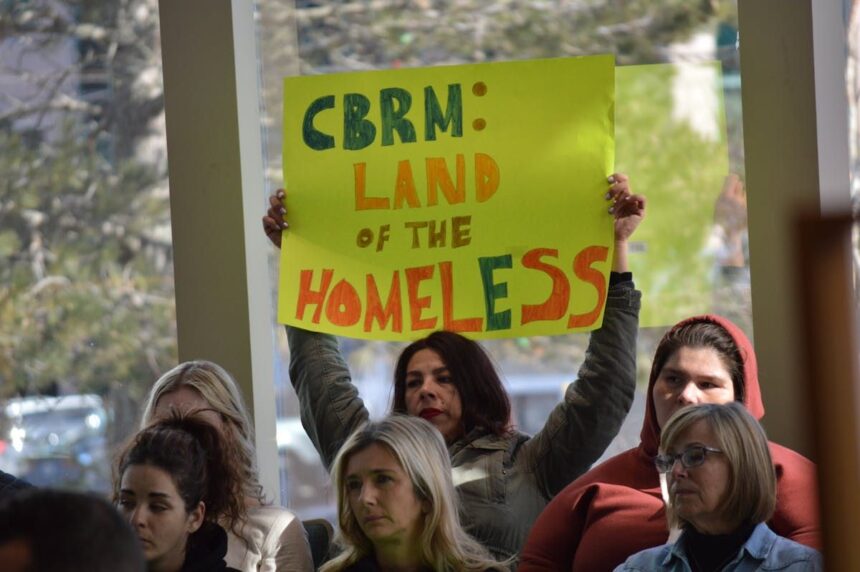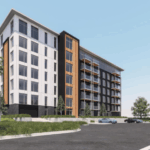Build community, not barriersPublished Sep 15, 20255 minute readIn this file image from 2023, a sign of discontent is held by an individual attending CBRM council meeting over the municipality rejecting $5 million in funding for affordable housing aimed at the most vulnerable. Community groups are now concerned with a bylaw that could make it difficult to build supportive housing in the CBRM. Photo by Ian Nathanson /Ian NathansonArticle contentAt a time when all levels of government are prioritizing housing development and removing red tape, the Cape Breton Regional Municipality is looking to move in the opposite direction. At the Aug. 19 meeting of council, council voted unanimously to make it more difficult to build supportive housing in the CBRM. Led by Councillor Earlene MacMullin, council is seeking the authority to weigh in on individual supportive housing developments over nine units.THIS CONTENT IS RESERVED FOR SUBSCRIBERS ONLY.Subscribe now to access this story and more:Unlimited access to the website and appExclusive access to premium content, newsletters and podcastsFull access to the e-Edition app, an electronic replica of the print edition that you can share, download and comment onEnjoy insights and behind-the-scenes analysis from our award-winning journalistsSupport local journalists and the next generation of journalistsSUBSCRIBE TO UNLOCK MORE ARTICLES.Subscribe or sign in to your account to continue your reading experience.Unlimited access to the website and appExclusive access to premium content, newsletters and podcastsFull access to the e-Edition app, an electronic replica of the print edition that you can share, download and comment onEnjoy insights and behind-the-scenes analysis from our award-winning journalistsSupport local journalists and the next generation of journalistsRegister to unlock more articles.Create an account or sign in to continue your reading experience.Access additional stories every monthShare your thoughts and join the conversation in our commenting communityGet email updates from your favourite authorsSign In or Create an AccountorArticle contentArticle contentThe new (2023/2024) Master Planning Strategy and Land Use Bylaw (LUB) state that supportive housing of up to nine units can be built “as of right.” This means that these projects do not require any special planning approvals. They can be built just as any other nine-unit housing development can be built, once a building permit is in hand.Article contentArticle contentFor supportive housing developments greater than nine units, the proponent must submit their site plan to the CBRM Planning Department. The site plan is reviewed by the Planning Department for adherence to the Land Use Bylaw and distributed to neighbours within 30 metres of the project. These neighbours are invited to comment on the site plan.Article contentThis provision is designed to ensure that larger supportive housing developments fit in with the surrounding neighbourhood aesthetically: do they meet all required setbacks, is parking screened from sight (with trees or bushes), is signage of an appropriate size? This check is not designed to evaluate or comment on the individuals who will live in the development, as that would be discriminatory.Article contentArticle contentHOUSING AS A RIGHT IN CANADAArticle contentAge, income, disability, addiction, and mental illness are protected categories in the Nova Scotia Human Rights Act, and they can’t be used to decide who is allowed to live where (housing, along with employment, and access to services, are areas in which discrimination on the basis of protected categories is explicitly prohibited). Equitable access to adequate housing is a human right that we as a community must advance (https://www.chrc-ccdp.gc.ca/individuals/right-housing/housing-human-right).Article contentIn 2023, the CBRM applied for and received $11.4 million from the federal Housing Accelerator Fund (HAF). From the HAF website, “The Housing Accelerator Fund will provide incentive funding (contributions) to local governments to encourage local initiatives that remove barriers to housing supply, accelerate the growth of supply and support the development of complete, low-carbon and climate-resilient communities which are affordable, inclusive, equitable and diverse.”Article contentThe motion to inject council oversight and approval in the supportive housing development process for all developments over nine units runs contrary to the commitments made by the CBRM for the Housing Accelerator Fund, which they continue to administer.Article contentSPECIFICS OF SUPPORTIVE HOUSINGArticle contentSupportive housing recognizes, in addition to four walls and a roof, many of us will also need long-term wrap-around supports to help us stay housed and work towards goals like health, stability, autonomy, education, employment, reunification with family and friends, and overall well-being.Article contentSupportive housing comes in many forms and serves many populations – individuals with physical and intellectual disabilities, individuals with complex mental health diagnoses, seniors, individuals exiting homelessness, individuals living with addictions, young people aging out of the foster care system, women and children fleeing domestic violence, and more.Article contentArticle contentThe size of any given development is a function of multiple factors: who it is designed to serve, staffing levels, location and land parcel, funding agreements with different levels of government, and national and international best practices. The CBRM is home to supportive housing that ranges from small initiatives to ones that are as large as 70 units or more.Article contentSUPPORTIVE HOUSING ACROSS N.S.Article contentThe necessity and inclusion of all types of supportive housing is recognized by municipalities across Nova Scotia. Supportive housing is not referenced as distinct from housing in the Land Use Bylaws of Antigonish or Truro or Kings County, for example. In Halifax, supportive housing falls in the broader category of Shared Housing, which includes supportive housing, group homes, residential care facilities, transitional housing, and rooming houses. It is permitted in all residential zones and only has to meet the same zone provisions as all other housing in that zone.Article contentArticle contentIn none of these examples is supportive housing singled out as being different from other housing or potentially problematic and so requiring council weigh in on each individual development. Other municipalities in the province recognize, among other things, that adding barriers to development is going to make it far less likely that non-profits (who provide supportive housing and can secure grants for both construction and the wrap-around supports) will pursue any new housing developments.Article contentSOURCE OF CLARITY AND FAIRNESSArticle contentOne of the purposes of having land use bylaws is to provide clarity and fairness by applying the same rules to everyone, thereby creating predictability for residents, developers, and businesses. The more that mayor and council separate out supportive housing (from housing in general), the more they risk – intentionally or unintentionally – discriminating against the individuals living in supportive housing.Article contentSometimes, in the work we do, we’re asked the question “but what about our rights?” from community members. We absolutely have rights. We have a right, for example, to the quiet and peaceful enjoyment of our home. We too have the right not to be discriminated against (based on age, class, race, disability, mental illness, income, etc.) when we seek housing. We do not, however, have the right to decide who is going to live next to us (unless we have the means to buy up the properties around us).Article contentA CHANGING COMMUNITYArticle contentOur communities are changing in ways that we are not familiar with. There are more people living on the streets. There are more people living – publicly and privately – with addictions, poverty, and mental illness. As much as we may not like this, there is no stuffing the genie back in the lamp. Addictions, mental illness, poverty, and homelessness have complex causes that develop over lifetimes and there are no quick fixes. As we work to get at the root causes today and for the next generation, there are interventions like supportive housing that can make an immediate difference in people’s lives.Article contentArticle contentWe, the undersigned, call on the CBRM to: (1) live up to the commitments it made in accepting the Housing Accelerator Funding; (2) follow the lead of other municipalities in the province who do not treat supportive housing as distinct from housing in general; (3) follow the lead of both the province and federal government in their efforts to remove, not add, barriers to housing development in the midst of a housing crisis and in the context of the Nova Scotia Human Rights Act.Article contentArticle contentAlison Grittner, Assistant Professor, Department of Social Work, CBUArticle contentCatherine Leviten Reid, Professor, Community Economic Development, CBUArticle contentJodi McDavid, Executive Director, Cape Breton Transition House Association – Willow HouseArticle contentKristie Marsh, Executive Director, Every Women’s CentreArticle contentKristen Jones, Operations Manager, Every Woman’s CentreArticle contentChris Porter, Executive Director, Ally Centre of Cape BretonArticle contentErika Shea, CEO/President, New Dawn EnterprisesArticle contentPatti MacDonald, Executive Director, TownhouseArticle content
OPINION: Community groups concerned with CBRM housing development changes











